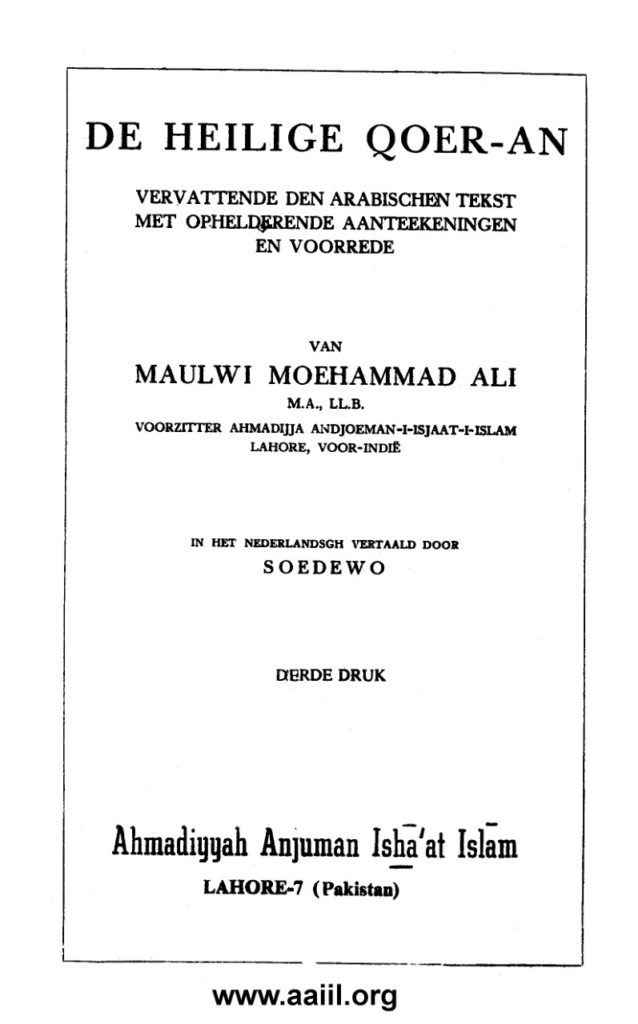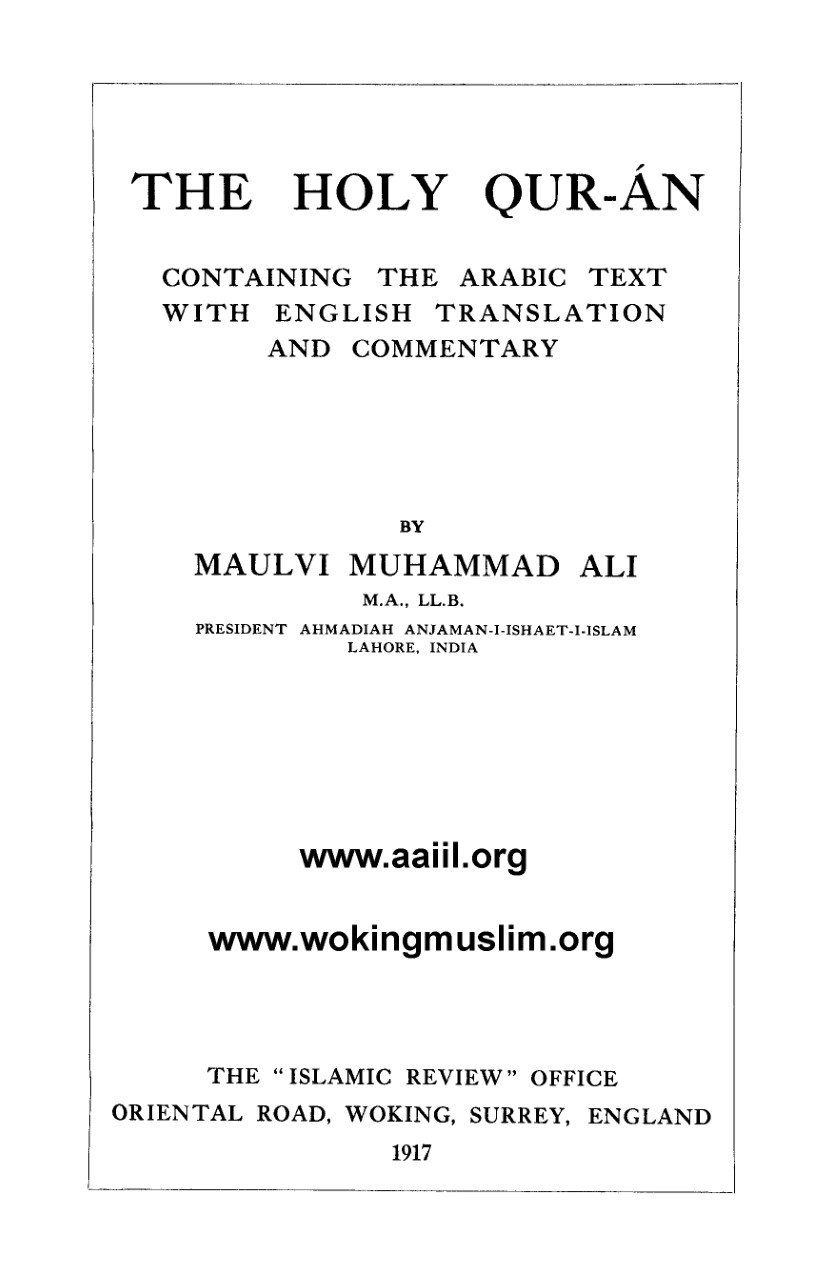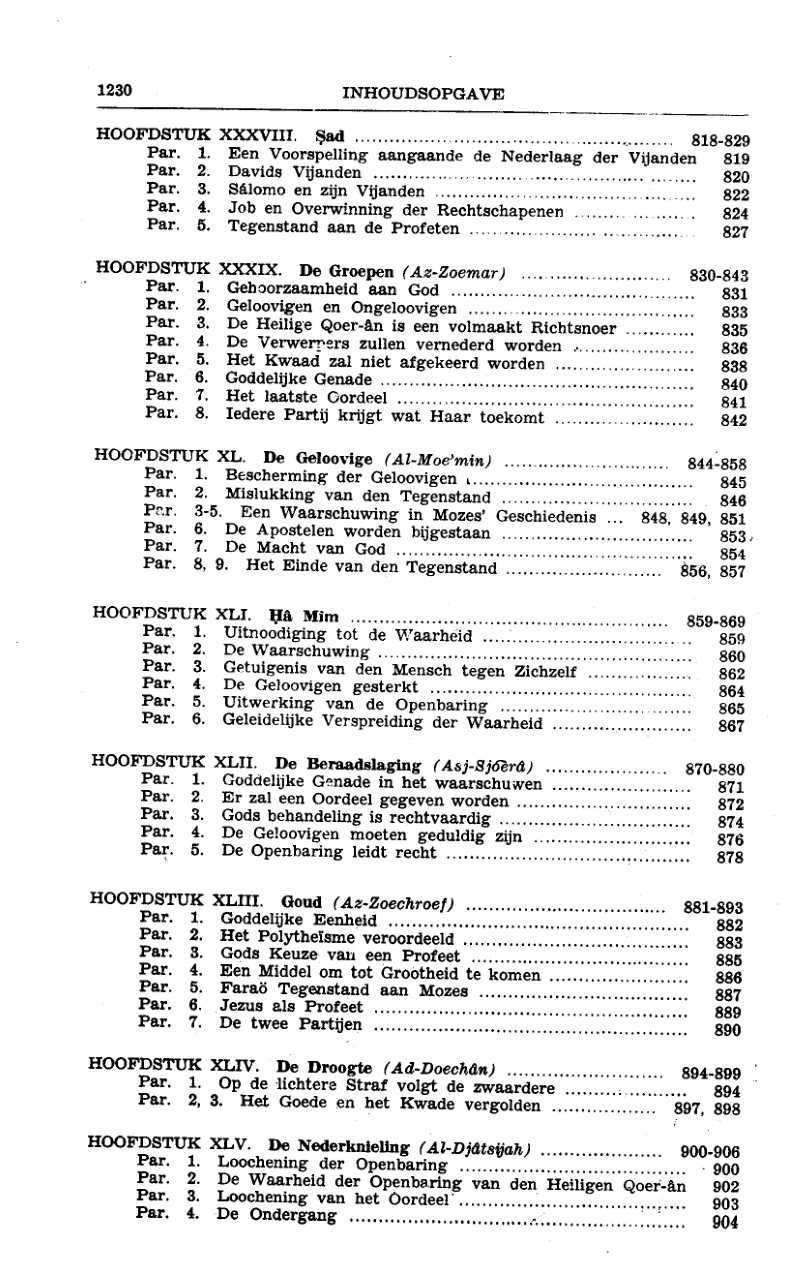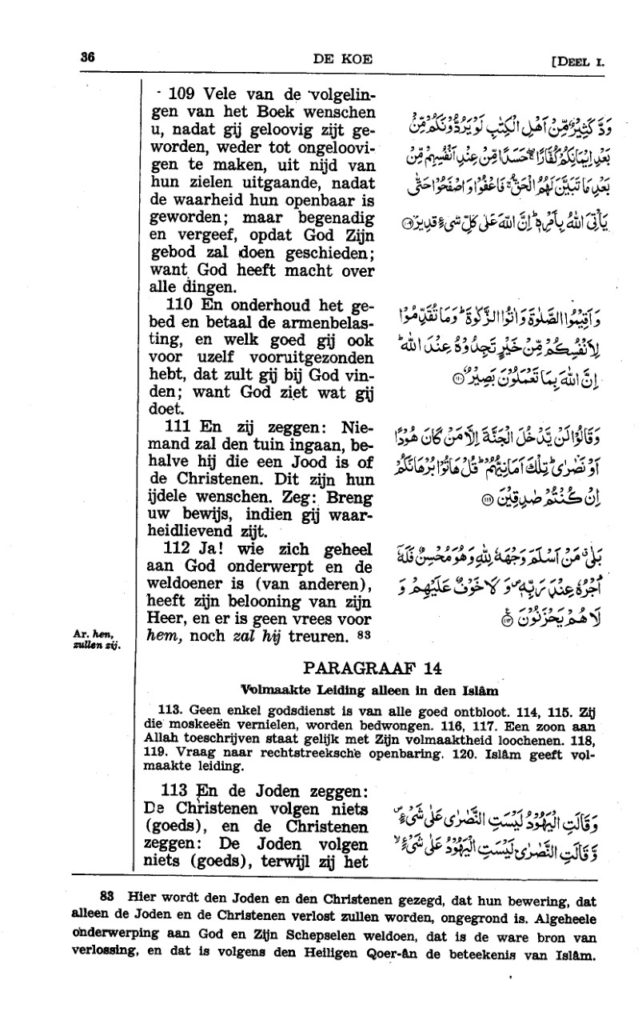The first Dutch Qur’an translation of the 20th century was authored by a young Javanese Muslim, Soedewo (1906–1971), and printed in Batavia in 1934 for an Indonesian audience. While criticized by some ulama for being an Ahmadiyya translation, it was enthusiastically hailed by Indonesian Sunni intellectuals. For several decades, it was probably the most widely used Qur’an translation among the anti- and post-colonial Indonesian elites. The story of its publication and success is indicative the global context in which the modern genre of Qur’an translation emerged. The story of how it fell out of use highlights transformations of linguistic and sectarian identity that occured in the course of the 20th century.
Soedewo was part of a generation of Indonesians who were educated at colonial schools and, rather than becoming obedient colonial administrators, ended up fighting for the independence of their countries. As such, he is a typical example of the the type of anti-colonial nationalist that Benedict Anderson describes in „Imagined Communities”. Trained in the Dutch language with Dutch curricula, this generation of young Indonesians dreamed up an independent nation and wanted to connect with its cultural and religious heritage. But the Islam of traditional ulama and Sufi shaykhs was linguistically inaccessible to them. Moreover, they perceived it as old-fashioned, superstitious and inattractive, representing everything that colonizers and Christian missionaries criticized about Islam. Therefore, like many of his generation, Soedewo was active in various revivalist organizations such as the Muhammadiyah, founded in 1912, the Muslim Youth Association (Jong Islamieten Bond), founded in 1925, and finally the Lahore Ahmadiyya Movement that appeared on the Indonesian scene in 1924 and brought with it the English Qur’an translation by their spiritual leader, Muhammad Ali, first published in 1917.
The Ahmadiyya movement had been founded in British India by Mirza Ghulam Ahmad (1835-1908). Shortly after his death, arguments over his legacy and succession arose and resulted in a split of the movement into the Qadyan branch, which believed that Mirza Ghulam Ahmad was the promised Messiah and called his successors caliphs, and the Lahore branch which saw Mirza Ghulam Ahmad as a reformer. Under the leadership of Muhammad Ali (1874-1951), the Lahore Ahmadiyya pursued missionary activities across the world, including the European centres of colonial empires. The publication of an English Qur’an translation and commentary in 1917 was part of that agenda. Printed in many editions and re-translated into numerous languages, it contributed to the emergence of an entirely new genre of Qur’an translation. This genre was part of what made Soedewo’s translation of Muhammad Ali’s work attractive in Indonesia because it conformed to a style of print publication that Dutch-trained intellectuals were familiar with.
Of course, South-east Asian Muslims had rendered the Qur’an into vernacular languages for centuries and some of these efforts had even been printed in the decades before Soedewo’s translation was first published. However, none of these works looked like Soedewo’s edition. They were either interlinear translations where the focus was on the Arabic text of the Qur’an which was explained word for word between the lines; or they were paraphrases of the Qur’an along the lines of a concise tafsir, containing exegetical expansions such as specifying the names of speakers and addressees not mentioned in the Qur’an and filling ellipses in the text. Conversely, Soedewo, like Muhammad Ali, strove for a rendering that was as close to the source text as possible but, unlike an interlinear translation, provided a coherent target text. A lengthy introduction to Islam and the Qur’an, introductions to individual surahs, page headers and the insertion of section headings all served to make the work accessible to readers without any training in the Islamic religious sciences, Muslims and non-Muslims alike. Thousands of footnotes deliver a copious commentary, clearly separated from the translation. Since the notes in the 1917 editions were extremely extensive, Muhammad Ali published a new version in 1928 that contained fewer and shorter notes. Soedewo obviously thought that this met the expectations of his target group because, while generally following the 1917 edition, he based his translation on the notes of the 1928 edition. Since the two editions had different introductions, Soedewo simply translated both, resulting in a front matter that makes up nearly 200 pages of his 1.400-page work.
The layout, while including the Arabic text and thereby distinguishing the work from biblical translations, follows European typographic conventions. The translation and the Arabic text are typeset in two adjacent colums. Necessary grammatical deviations from the Arabic source text are marked in the margins.
Muhammad Ali opted for a mode of translation that was reminiscent of biblical translations, including a deliberately archaic King James style (see, for example, Q 1:6: “the path of those upon whom Thou hast bestowed favors…”). Soedewo tried to imitate this by using the archaic second-person Dutch pronoun „Gij“: “Het pad dergenen wien Gij gunsten hebt geschonken”. While he strove to remain true to Muhammad Ali’s choices, he deviated from his model in at least one important aspect. His desire to ban potentially unfamiliar Arabic-Islamic technical terms from his translation went so far that, unlike Muhammad Ali, who translated “allāh” as “Allah”, he opted for the Dutch designation “God”.
His was already the second project of translating Muhammad Ali’s translation in Indonesia. The first was a translation into Malay, projected to become the language of an independent Indonesia, that the famous nationalist Tjokroaminoto began to work on in the late 1920s. The project elicited fierce opposition especially on the part of the reformist Muhammadiyah who had initially had cordial relations with the Ahmadiyya but by the late 1920s had grown distrustful of them. Muhammadiyah representatives eventually asked Rashīd Riḍā from Egypt, whose journal “al-Manār” was famous among Indonesian reformists, for a fatwa against the translation. Rashīd Riḍā vehemently attacked the project, first, because he was opposed to the idea of producing a “literal translation” of the Qur’an for fear that it might replace the source text, and second, because he was just as vehemently opposed to the Ahmadiyya, without distinguishing much between its two branches.
Despite the Muhammadiya’s opposition, Tjokroaminoto received the blessing of the Council of Indonesian ulama and pursued his project which was, however, left incomplete due to his illness and premature death. Nor did opposition to the Ahmadiyya or the general idea of translating the Qur’an prevent Soedewo from completing his translation into Dutch which, as mentioned above, turned out to be a great success and probably the most widely used Qur’an translation of the pre-independence period. The translation was frequently quoted by the first president of the Republic of Indonesia, Sukarno, in his speeches, and it could be found in most Muslim elite households. Dutch, at the time, was obviously more than the language of a Christian empire; it had become a Muslim language, too, and there was a corresponding demand for Islamic literature in Dutch.
This was because most of the Indonesian nationalist elite had been educated in Dutch schools, like Soedewo. Graduates of these schools typically knew no Arabic, could only read Latin script, had a poor command of the literary traditions of local languages such as Malay and Javanese, and had received no religious training that would have allowed them to understand a Qur’anic commentary which discusses grammar or hadith. Soedewo’s work was the first book that gave them access to the Qur’an. It was printed, widely distributed and therefore easy to obtain. And, maybe just as importantly, it presented a modernist and sometimes apologetic understanding of Islam that allowed its Indonesian readers to defend their religion against accusations of backwardness.
For example, in Surat al-Naml (Q 27:18-19), Solomon’s army reaches the “Valley of the Ants” (Wādī al-Naml) whereupon an ant (namla) speaks, warning the other ants (naml) to enter their homes so Solomon’s army does not crush them unwittingly. Solomon, able to understand these words, smiles upon hearing them. Unhappy with the mythological quality of this story, Muhammad Ali understood the Valley of the Ants” to be a proper name and the “Naml” to be a tribe who lived there. He thus translated:
“Until when they came to the valley of the Naml, a Namlite said: O Naml! enter your houses…”
Soedewo rendered this as,
“Tot, toen zij tot de vallei van den Naml kwamen, een Namliet zei: O Naml! ga in uw huizen…”
Thus, Soedewo’s readers did not have to contend with a miraculous event or a human’s supernatural abilities, which made his translation preferable to the ornate stories of the village teachers.
In some cases, Muhammad Ali’s commentary in the footnotes explains Qur’anic verses in a way that would mitigate their shock value for European-educated readers, for example with regard to Q 4:34 where Muhammad Ali and Soedewo explain that, while the verse might theoretically allow a husband to hit his wife, this is a last resort in extreme cases and moreover restricted to a light tap with a toothbrush. On Q 5:51 (“Oh you who believe! Do not take the Jews and Christians ‘awliyāʾ’…”), the commentary explains that the prohibition against taking Jews and Christians as “friends” is exclusively applicable to situations in which Jews and Christians wage war against Muslims.
Given the extent to which Soedewo’s translation fulfilled the need of Dutch-educated Muslims, the work’s occasional concessions to beliefs specific to the Ahmadiyya, for example related to the death of Jesus, must have seemed negligible to them, if they even recognized these allusions to non-mainstream doctrines. Moreover, Soedewo’s undeniable nationalist credentials protected him from an accusation that haunted the Ahmadiyya movement in India, namely their rejection of armed resistance and their refusal to frame violent anticolonial struggle as jihad.
Soedewo’s translation demonstrates the impact that the Lahore Ahmadiyya’s activities had on the field of Qur’an translation. Many subsequent Indonesian translations, including the one published by the Indonesian government starting in 1965, followed its example, opting for the same type of two-column layout with footnotes. Soedewo’s translation was reprinted multiple times, not only in Indonesia but also in Suriname.
The case of Soedewo’s Qur’an translation thus demonstrates that, far into the post-indepence period, sectarian boundaries between Muslim reformists and the Ahmadiyya movements, especially the Lahore Ahmadiyya, were fluid. Towards the end of the 20th century, this changed. Demonization of the Ahmadiyya contributed to the marginalization of their Qur’an translations in Indonesia. By that point, of course, few Indonesians were able to even read Soedewo’s translation since knowledge of Dutch had all but vanished. However, by the 1950s, Muhammad Ali’s work had been translated into Javanese and by the 1970s, into the Indonesian language. Today, even reformist Indonesian intellectuals tend to emphasize their Sunni identity and the Ahmadiyya are widely considered heretical. This should, however, not obscure the Ahmadiyya movements’ importance to the formation of Indonesian as well as global discourses on Qur’an translation.
(See the studies by Ahmad Najib Burhani, here, and Moch. Nur Ichwan, here).
Johanna Pink





